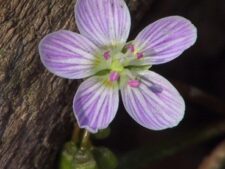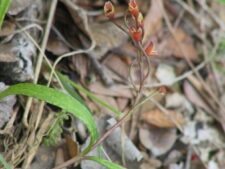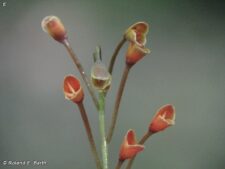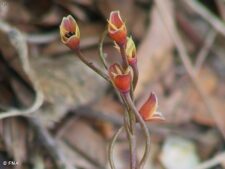
SPRING BEAUTY
Claytonia virginica
PURSLANE FAMILY (Portulacaceae)
 Identification
Identification
- Flowering time - Late March, April, Early May - often the first wildflower to bloom
- Common in upland woods, ravines at FF; less common at NW
- 5 white, pink or pink striped petals
- Long, narrow leaves
This native perennial is found in colonies. The long, narrow leaves emerge in bunches from bulbs in the ground. The flowers, about 1/2 inch across with 5 petals, are in clusters on stems up to 6 inches tall. The flower petals are variable in color, from pure white to various shades of pink to purple (A,C). Flowers often close by afternoon and may not open at all on cloudy days. The fruit capsules, first green and yellow, turn orange to red (D,E,F). They appear flower-like and produce black seeds.
One of the first flowers to appear in the spring, often in the last few days in March and continuing into early May. Common at Fontenelle Forest, especially in open upland woods. Less common at Neale Woods where it is found mainly in the upland woods above Rock Creek.
Native Americans of our region relished the starchy bulbs raw or boiled.
Many of our spring wildflowers including Spring Beauty have an interesting method of seed dispersal. Seeds have a fleshy organ called an elaiosome which is attractive to ants. The ants take the elaiosome to the nest where they eat it, but not the seed, which ends up in the nest debris where it is protected until germination.
The content of NatureSearch is provided by dedicated volunteer Naturalists of Fontenelle Forest who strive to provide the most accurate information available. Contributors of the images retain their copyrights. The point of contact for this page is: Roland Barth.





